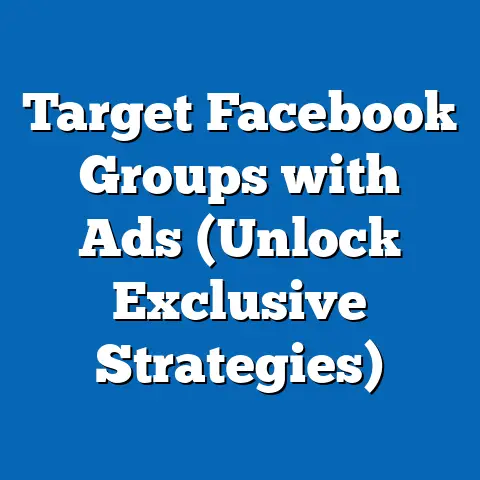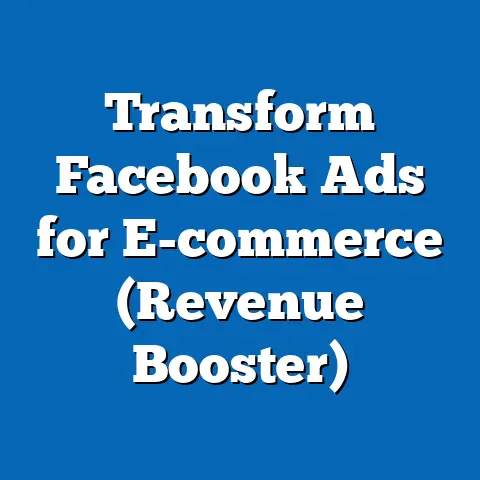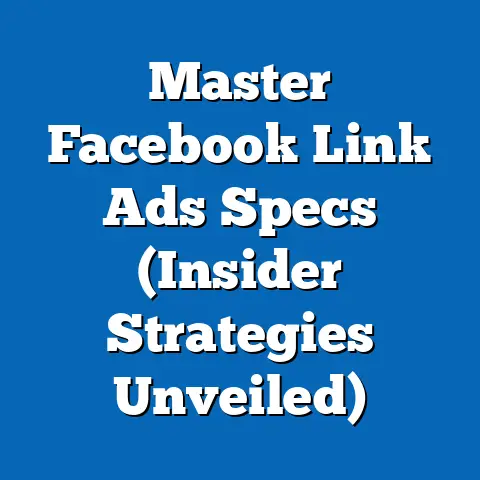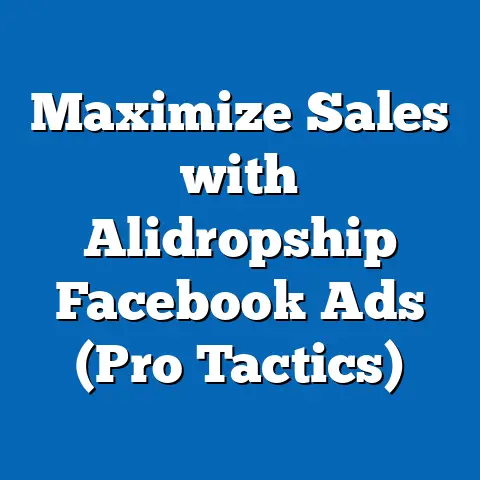Master Facebook Ad Templates for Success (Essential Tools)
Let’s face it: crafting the perfect Facebook ad sometimes feels like trying to explain TikTok trends to your grandparents—there’s a generational gap, a tech barrier, and a whole lot of confusion. But in a world where a single ad can reach millions across different age groups, mastering the art of Facebook advertising is no laughing matter. Whether you’re targeting Baby Boomers reminiscing over vinyl records or Gen Z scrolling through memes, understanding generational nuances is key to creating ads that resonate.
This article dives deep into the world of Facebook ad templates as essential tools for success, with a unique lens on how generational differences shape ad effectiveness. We’ll explore the defining characteristics of key generations—Baby Boomers, Gen X, Millennials, and Gen Z—while grounding our analysis in historical context and societal trends. Beyond just templates, we’ll unpack how technological, cultural, and economic factors influence ad reception and discuss the broader implications for businesses, marketers, and society.
Section 1: Understanding Generational Cohorts in the Digital Age
Defining Generations: Who Are We Talking To?
Generations are often defined by shared experiences, historical events, and cultural shifts that shape their worldview. While these labels can sometimes oversimplify complex human behavior, they provide a useful framework for understanding broad trends in consumer preferences and digital engagement. Let’s break down the key generations active on Facebook today, based on widely accepted demographic research.
-
Baby Boomers (1946-1964): Born in the post-World War II era, Boomers grew up during a time of economic prosperity and social change, witnessing the civil rights movement and the moon landing. Now aged 59-77, they represent a significant portion of Facebook’s user base, with over 25% of U.S. Boomers actively using the platform (Pew Research Center, 2023). They value trust, nostalgia, and straightforward messaging in ads.
-
Generation X (1965-1980): Often called the “forgotten generation,” Gen Xers came of age during the rise of personal computing and the end of the Cold War. Aged 43-58, they are digitally savvy but skeptical of overt marketing, prioritizing authenticity and value. They make up about 20% of Facebook users and are often decision-makers in households (Statista, 2023).
-
Millennials (1981-1996): Shaped by the internet’s early days, 9/11, and the 2008 financial crisis, Millennials (aged 27-42) are digital natives who value experiences over possessions. They are a dominant force on social media, with 30% of Facebook’s global users falling into this cohort (Hootsuite, 2023). They respond well to purpose-driven and visually engaging ads.
-
Generation Z (1997-2012): The youngest cohort, aged 11-26, grew up with smartphones and social media as constants. Having faced global challenges like climate change and the COVID-19 pandemic, Gen Z prioritizes inclusivity, sustainability, and humor in content. They are less dominant on Facebook compared to platforms like TikTok but still represent a growing segment (eMarketer, 2023).
These generational definitions are not rigid—individual experiences vary widely based on geography, socioeconomic status, and personal circumstances. However, they offer a starting point for tailoring Facebook ad templates to diverse audiences.
Historical Context: How the Past Shapes Digital Behavior
Each generation’s formative years play a critical role in how they interact with technology and advertising. For Baby Boomers, the transition from traditional media (TV, radio) to digital platforms like Facebook represents a significant shift, often driven by a desire to stay connected with family. Their historical context—think the rise of consumer culture in the 1950s and 60s—makes them responsive to ads that evoke nostalgia or emphasize reliability.
Gen X, often described as the “latchkey” generation, grew up with less parental oversight and more exposure to emerging tech like MTV and early PCs. Their historical backdrop of economic uncertainty (e.g., the 1980s recession) fosters a pragmatic approach to spending, meaning ads must clearly demonstrate value. Millennials, on the other hand, came of age during rapid technological advancements and global connectivity, making them adept at filtering out inauthentic content in a crowded digital space.
Gen Z’s historical context is uniquely digital—born into a world of instant information, they’ve never known life without the internet. Events like the 2008 financial crisis (experienced through their parents) and the 2020 pandemic have instilled a sense of resilience and skepticism toward traditional institutions. For advertisers, this means Gen Z demands transparency and social responsibility in messaging.
Understanding these historical underpinnings helps marketers craft Facebook ad templates that don’t just sell a product but tell a story relevant to each generation’s lived experience. It’s not just about what you’re selling—it’s about why it matters to them.
Section 2: The Role of Facebook Ad Templates in Generational Marketing
Why Templates Matter: Efficiency Meets Personalization
Facebook ad templates are pre-designed frameworks that streamline the creation of visually appealing and strategically targeted advertisements. They include placeholders for images, text, and calls-to-action (CTAs), allowing marketers to customize content while maintaining consistency in branding. In a platform where over 2.9 billion monthly active users compete for attention (Meta, 2023), templates are essential tools for standing out—especially when tailoring content to generational preferences.
Templates save time and ensure that ads adhere to Facebook’s design guidelines (e.g., image dimensions, text limits). More importantly, they provide a foundation for A/B testing different messaging styles across demographics. For instance, a template with a nostalgic image might resonate with Boomers, while the same layout with a trendy meme could target Gen Z.
Generational Preferences in Ad Design
Each generation interacts with visual and textual elements differently, influenced by their cultural touchpoints and tech familiarity. Baby Boomers, for example, often prefer clear, legible fonts and images that evoke familiarity—think family gatherings or retro aesthetics. A 2022 study by Nielsen found that 68% of Boomers are more likely to click on ads that feature real people over abstract graphics.
Gen X, balancing digital comfort with traditional values, responds to ads that blend humor with practicality. Templates for this group might include bold CTAs like “Shop Now for Deals” paired with relatable imagery. Millennials, accustomed to polished social media content, gravitate toward minimalist designs with vibrant colors and authentic storytelling—think user-generated content or behind-the-scenes visuals.
Gen Z, the most visually literate generation, demands creativity and immediacy. Templates targeting this group often incorporate short, snappy videos or GIFs, with text overlays that mimic social media trends (e.g., “Sliding into your feed like…”). According to a 2023 report by Sprout Social, 74% of Gen Z users on Facebook engage with ads that feel “meme-worthy” or interactive.
By adapting templates to these preferences, marketers can ensure their ads don’t just blend into the endless scroll but spark genuine interest. It’s about speaking the visual language of each generation without resorting to clichés or overgeneralizations.
Section 3: Technological, Economic, and Social Factors Influencing Ad Reception
Technology: The Digital Divide and Convergence
Technology shapes how generations interact with Facebook ads, from device usage to platform familiarity. Baby Boomers, who adopted social media later in life, often access Facebook via desktops or tablets, preferring larger screens for readability. This means templates for Boomers should prioritize high-contrast designs and minimal clutter to ensure visibility.
Gen X and Millennials, having grown up alongside the internet’s evolution, are comfortable across devices but show slight differences—Gen X leans toward laptops, while Millennials are mobile-first. Templates for these groups should be responsive, adapting seamlessly to various screen sizes. Gen Z, as true digital natives, almost exclusively engages via smartphones, with a preference for vertical formats (e.g., Stories ads) that templates must accommodate.
The digital divide also plays a role. While 83% of U.S. adults across generations use Facebook, access to high-speed internet and modern devices varies, particularly among older Boomers in rural areas (Pew Research Center, 2023). Marketers must ensure templates load quickly and function well on lower-end devices to avoid alienating segments of their audience.
Economic Factors: Purchasing Power and Priorities
Economic conditions during a generation’s formative years influence their spending habits and, by extension, their response to ads. Baby Boomers, many of whom are retired or nearing retirement, often have disposable income but prioritize value and necessity over impulse buys. Templates targeting Boomers should highlight discounts or long-term benefits (e.g., “Save 20% on Essentials!”).
Gen X, often in their peak earning years, balances financial responsibilities like mortgages and childcare. They respond to ads offering practical solutions or time-saving products, so templates should emphasize efficiency and reliability. Millennials, shaped by the 2008 recession, are cautious spenders who value experiences—templates for this group might focus on lifestyle benefits or social impact (e.g., “Support Sustainable Brands”).
Gen Z, entering the workforce during economic uncertainty (post-COVID recovery), is budget-conscious but willing to invest in brands aligning with their values. Templates targeting Gen Z should showcase affordability alongside ethical messaging (e.g., “Eco-Friendly and Under $20”). Understanding these economic underpinnings ensures that ad templates don’t just attract clicks but drive conversions.
Social and Cultural Influences: Values in the Spotlight
Cultural shifts and social movements also dictate how generations perceive ads. Baby Boomers, raised during times of traditional gender roles and family-centric values, often appreciate ads reflecting stability and community. Templates for this group might feature warm, inclusive imagery of multigenerational families.
Gen X, influenced by the rise of individualism in the 1980s, values self-expression and independence. Templates should avoid overly corporate tones, instead opting for relatable, conversational copy. Millennials, shaped by globalization and social media, prioritize diversity and authenticity—templates must reflect inclusivity in visuals and messaging to avoid backlash.
Gen Z, growing up in an era of social activism (e.g., Black Lives Matter, climate strikes), expects brands to take a stand. A 2023 Edelman Trust Barometer report found that 70% of Gen Z users will unfollow or boycott brands that fail to address social issues. Templates for this cohort should integrate bold statements or hashtags (e.g., #SustainableFuture) while maintaining authenticity—empty virtue signaling won’t cut it.
By weaving these technological, economic, and social factors into Facebook ad templates, marketers can create campaigns that resonate on a deeper level. It’s not just about selling; it’s about connecting with the values and realities of each generation.
Section 4: Comparing Generational Responses to Facebook Ad Templates
Engagement Metrics: Who Clicks, Who Scrolls?
Data on engagement reveals stark differences in how generations interact with Facebook ads, which templates must account for. Baby Boomers, for instance, have a higher click-through rate (CTR) on ads with emotional storytelling—think heartwarming testimonials or family-oriented content. A 2022 Meta analysis found that Boomers’ CTR averages 2.1% for such ads, compared to the platform’s overall average of 1.2%.
Gen X shows a preference for informational ads, with a CTR of 1.8% on content offering clear value propositions (e.g., product comparisons). They are less likely to engage with flashy visuals, prioritizing substance over style. Millennials, conversely, engage most with interactive formats like polls or carousel ads, boasting a CTR of 1.5% when ads feel personalized (Meta, 2023).
Gen Z, while less active on Facebook than other platforms, engages at a high rate (CTR of 2.3%) with video ads under 15 seconds, especially those incorporating humor or trends. However, their attention span is short—templates must hook them within the first 3 seconds or risk being scrolled past. These metrics highlight the importance of customizing templates not just for content but for format and pacing.
Pain Points and Preferences: Avoiding Missteps
Each generation has unique pain points that poorly designed templates can exacerbate. Boomers often cite overly complex ads or small text as reasons for disengagement—templates must prioritize simplicity and accessibility. Gen X dislikes ads that feel intrusive or overly salesy, so templates should avoid aggressive CTAs in favor of subtle nudges like “Learn More.”
Millennials, bombarded by content daily, are quick to spot inauthenticity—templates relying on stock photos or generic messaging often fall flat. They prefer ads that feel like a natural extension of their feed. Gen Z, hyper-aware of marketing tactics, rejects anything that feels “cringe” or out of touch—templates must stay current with slang, visuals, and cultural references without trying too hard.
Comparing these responses underscores a key takeaway: one-size-fits-all templates don’t work. Success lies in iteration—testing and refining designs based on real-time feedback and generational insights.
Section 5: Societal and Workplace Implications of Generational Ad Strategies
Societal Impact: Shaping Perceptions and Behaviors
Facebook ad templates don’t just influence purchasing decisions; they shape societal perceptions across generations. For Baby Boomers, ads that reinforce traditional values or nostalgia can strengthen a sense of cultural continuity, but they risk alienating younger users if overdone. Conversely, templates targeting Gen Z with progressive messaging (e.g., inclusivity, sustainability) can drive broader cultural shifts by normalizing these values in public discourse.
However, there’s a flip side. Over-targeting specific generations with tailored templates can deepen societal divides, creating echo chambers where users only see content reinforcing their existing beliefs. A 2023 study by the University of Southern California found that 62% of social media users feel algorithms (including ad targeting) contribute to polarization. Marketers must balance personalization with inclusivity, ensuring templates don’t exclude or stereotype.
Workplace Implications: Bridging Generational Teams
In the workplace, understanding generational ad preferences can enhance internal marketing strategies and team dynamics. Many companies use Facebook ads for recruitment, and templates must appeal to diverse age groups applying for roles. For instance, a template targeting Gen X professionals might emphasize career stability and benefits, while one for Millennials could highlight flexible work arrangements and company culture.
Moreover, marketing teams often span generations, bringing varied perspectives to ad creation. A Boomer manager might prioritize traditional metrics like reach, while a Gen Z designer pushes for viral, trend-driven content. Templates can serve as a common ground, providing structure while allowing room for creative input. Organizations that foster cross-generational collaboration in ad design often see higher campaign success rates, with a 2022 Deloitte report noting a 15% increase in ROI for diverse marketing teams.
Economic Implications: Driving Market Trends
Generational ad strategies also influence broader economic trends. Baby Boomers, controlling significant wealth (estimated at $78 trillion globally by McKinsey, 2023), drive markets for healthcare, retirement services, and luxury goods—templates targeting them can shift industry priorities. Millennials and Gen Z, with growing purchasing power, push demand for sustainable and tech-driven products, influencing how businesses allocate ad budgets.
Templates that successfully engage these cohorts can create ripple effects, from boosting small businesses to reshaping corporate social responsibility (CSR) initiatives. However, overemphasis on younger generations risks neglecting Boomers’ economic clout, while ignoring Gen Z’s values could alienate future consumers. Balance is key.
Section 6: Practical Strategies for Crafting Generational Facebook Ad Templates
Step 1: Research and Segment Your Audience
Before designing templates, conduct thorough audience research using tools like Facebook Insights and third-party data (e.g., Nielsen, Pew). Segment your audience by age, location, interests, and behaviors, ensuring you capture generational nuances. For instance, urban Millennials might prioritize convenience, while rural Boomers value community-focused messaging.
Step 2: Customize Visual and Textual Elements
Tailor templates to generational design preferences. Use warm, nostalgic imagery for Boomers, bold and practical layouts for Gen X, sleek and authentic visuals for Millennials, and trendy, fast-paced content for Gen Z. Keep text concise—Boomers and Gen X prefer clarity, while Millennials and Gen Z want punchy, emotive copy (e.g., “Join the Movement!”).
Step 3: Incorporate Relevant CTAs and Formats
CTAs should align with generational motivations. Boomers respond to “Discover More,” Gen X to “Get the Best Deal,” Millennials to “Be Part of Something Bigger,” and Gen Z to “Act Now!” Experiment with formats—static images for older cohorts, short videos or Stories for younger ones.
Step 4: Test and Iterate
Use A/B testing to refine templates based on performance metrics like CTR, engagement rate, and conversion. Test different headlines, images, and CTAs across generational segments, adjusting in real time. A 2023 HubSpot report found that campaigns with iterative testing see a 20% uplift in ROI.
Step 5: Stay Ethical and Inclusive
Avoid reinforcing stereotypes or excluding subgroups within generations. Ensure templates reflect diversity in visuals and messaging, and align with ethical standards (e.g., avoiding misleading claims). Transparency builds trust—a critical factor for all generations, especially Gen Z.
Conclusion: Looking Ahead with Generational Ad Templates
Mastering Facebook ad templates for generational success is both an art and a science. By grounding strategies in historical context, technological trends, and societal values, marketers can create campaigns that resonate across Baby Boomers, Gen X, Millennials, and Gen Z. These templates are more than tools—they’re bridges connecting diverse audiences in a fragmented digital landscape.
Looking forward, the rapid evolution of technology (e.g., AI-driven personalization, augmented reality ads) will further complicate generational targeting. Will Gen Z’s dominance on newer platforms pull them away from Facebook, or will the platform adapt to retain them? How will aging Boomers’ digital habits evolve as Gen Alpha enters the scene? These uncertainties remind us that flexibility is crucial—templates must evolve alongside generational shifts.
Ultimately, the goal isn’t just to sell but to foster meaningful engagement. As we refine these essential tools, let’s prioritize connection over conversion, understanding over assumption. In a world of endless scrolling, a well-crafted ad template might just be the pause that unites us all—Boomer to Zoomer.






